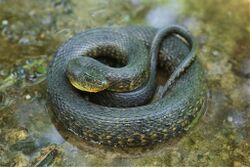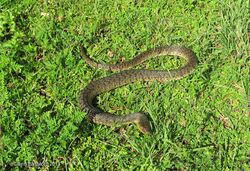Biology:Green water snake
| Green water snake | |
|---|---|

| |
| Nerodia cyclopion in Arkansas | |
| Scientific classification | |
| Domain: | Eukaryota |
| Kingdom: | Animalia |
| Phylum: | Chordata |
| Class: | Reptilia |
| Order: | Squamata |
| Suborder: | Serpentes |
| Family: | Colubridae |
| Genus: | Nerodia |
| Species: | N. cyclopion
|
| Binomial name | |
| Nerodia cyclopion (A.M.C. Duméril, Bibron &
A.H.A. Duméril, 1854)[1] | |
| Synonyms | |
The green water snake (Nerodia cyclopion) is a common species of nonvenomous natricine snake endemic to the southeastern United States .
Geographic range
N. cyclopion is distributed from the Florida panhandle westward to Louisiana, and northward through the Mississippi Valley into southern Illinois.[5]
More precisely, it is found in southwestern Alabama, southeastern Arkansas, northwestern Florida, southern Illinois, southwestern Indiana , western Kentucky, Louisiana, southern Mississippi, southeastern Missouri, western Tennessee , and southeastern Texas .[6]
The type locality is New Orleans, Louisiana.[5]
Description
N. cyclopion differs from most other species of North American water snakes by having one or more small scales under the eye, giving the appearance of a ring of small plates around the eye, a character shared only with the species N. floridana.
A heavy-bodied snake, N. cyclopion is dark green, olive, or brown dorsally. Ventrally, it is yellowish on the anterior third, and the on remainder dark brown with yellow or white semicircles.[3]
N. cyclopion averages 76–140 cm (30-55 inches) in total length (including tail).[7]
Habitat
N. cyclopion prefers still waters such as bayous, lakes, marshes, ponds, sluggish streams, and swamps. It is sometimes found in brackish water.[8]
Diet
The green water snake preys upon crayfish, frogs, and fish.[8]
Subspecies
The former subspecies, Nerodia cyclopion floridana (Goff, 1936), also known commonly as the Florida green water snake, has been elevated to a full species as Nerodia floridana.
Reproduction
The green water snake is ovoviviparous. Mating takes place on land in April. The young are born in July or August, and are about 25 cm (10 in) long. Brood size varies from 7 to 101, depending on the size of the female. The females, which are larger than the males and have two more dorsal scale rows, may weigh over 4.1 kg (9 lb).[6]
References
- ↑ "Nerodia cyclopion ". ITIS (Integrated Taxonomic Information System). www.itis.gov
- ↑ Boulenger, G.A. (1893). Catalogue of the Snakes in the British Museum (Natural History). Volume I., Containing the Families ... Colubridæ Aglyphæ, part. London: Trustees of the British Museum (Natural History). (Taylor and Francis, printers.) xiii + 448 pp. + Plates -XXVIII. (Tropidonotus cyclopium [sic], pp. 244-245).
- ↑ 3.0 3.1 Schmidt, K.P., and D.D. Davis (1941). Field Book of Snakes of the United States and Canada. New York: G.P. Putnam's Sons. 365 pp. (Natrix cyclopion cyclopion, pp. 215-216, Figure 70 + Plate 23, top, on p. 343).
- ↑ Smith, H.M., and E.D. Brodie Jr. (1982). Reptiles of North America: A Guide to Field Identification. New York: Golden Press. 240 pp. ISBN:0-307-13666-3 (paperback). (Nerodia c. cyclopion, p. 154).
- ↑ 5.0 5.1 Stejneger, L., and T. Barbour (1917). A Check List of North American Amphibians and Reptiles. Cambridge, Massachusetts: Harvard University Press. 125 pp. (Natrix cyclopion, pp. 94-95).
- ↑ 6.0 6.1 Wright, A.H., and A.A. Wright (1957). Handbook of Snakes of the United States and Canada. Ithaca and London: Comstock Publishing Associates a division of Cornell University Press. 1,105 pp. (in 2 volumes). (Natrix cylopion cyclopion, pp. 472-475, Figure 139 + Map 38 on p. 467).
- ↑ Conant, R. (1975). A Field Guide to Reptiles and Amphibians of Eastern and Central North America, Second Edition. Boston: Houghton Mifflin. xviii + 429 pp. + Plates 1-48. ISBN:0-395-19977-8 (paperback). (Natrix cyclopion cyclopion, pp. 139-140 + Plate 21 + Map 105).
- ↑ 8.0 8.1 Conant, R., and W. Bridges (1942). What Snake Is That? A Field Guide to the Snakes of the United States East of the Rocky Mountains. (with 108 drawings by Edmond Malnate). New York and London: D. Appleton-Century. Frontispiece map + viii + 163 pp. + Plates A-C, 1-32. (Natrix cyclopion cyclopion, pp. 90-91).
External links
- Species Nerodia cyclopion at The Reptile Database
Further reading
- Duméril, A.-M.-C., G. Bibron and A. Duméril (1854). Erpétologie générale ou histoire naturelle complète des reptiles, Tome septième.—Première partie. Comprenant l'histoire des serpents non venimeux. (=General Herpetology or Complete Natural History of Reptiles, Volume 7.—Part 1. Containing the [Natural] History of Nonvenomous Snakes). Paris: Roret. xvi + 780 pp. (Tropidonotus cyclopion, pp. 576–577). (in French).
- Goff, C.C. (1936). "Distribution and Variation of a New Species of Water Snake, Natrix cyclopion floridana, with a Discussion of its Relationships". Occasional Papers of the Museum of Zoology, University of Michigan (327): 1-12.
- Morris, P.A. (1948). Boy's Book of Snakes: How to Recognize and Understand Them. A volume of the Humanizing Science Series, edited by Jacques Cattell. New York: Ronald Press. viii + 185 pp. ("The Green Water Snake", pp. 82–84, 180).
Wikidata ☰ Q749037 entry
 |



